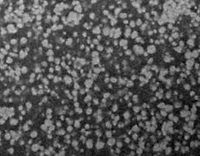All that Glitters And Sparkles, and Shifts, and Moves, and...
Driven by trends in fashion, sporting-goods, automotive and other consumer markets, pigments that generate special effects - color shift, movement, fluorescence, pearlescence - are enjoying demand growth rates that outpace the rate of volume increases in the coatings and pigment markets as a whole.
That's the view expressed by key marketing personnel with major suppliers of special-effect pigment products, such as Engelhard Corp., EM Industries Inc. and Silberline Manufacturing Co. Inc.
And despite recent slowdowns in economic growth in key industrial regions around the world, pigments that help coatings manufacturers and their customers achieve distinctive visual properties for their products continue to record solid growth trends, pigment suppliers say.
"The economic downturn we observed in 2001 slowed growth opportunities, but some market segments, such as electronics, appliances and various consumer products, have continued to show increased use of special-effect pigments," says Stephane Rochard, Engelhard's Marketing manager, Automotive and Powder Coatings. Anticipated economic recoveries will boost sales above double-digit growth rates in the coming years, he says.
David M. Grafflin, Business Team leader-Advanced Materials for Wacker Chemical Corp.'s Wacker Silicones Division, says market growth for special-effect pigments will average 10-15% for the next several years. He says such pigments are creating the next "color space" for markets and applications looking to move beyond silvers, pearlescents, and traditional metallics. Wacker Silicones entered the special-effect pigment market in recent years with the introduction of specialty silicone-based pigments.
Steven R. Gingrass, director of Marketing for Silberline, says demand for aluminum pigments has been on the rise thanks to interest in metallic effects. He cites the North American automotive market, where he says silver-colored vehicles have more than doubled in every vehicle category since 1998.
"This share increase, coupled with increased automobile demand over this time period, has led to a very strong market for our aluminum-based products," he says. "Additionally, we have seen growth in every one of our strategic markets over the last few years."

New-Product Arrivals Broaden Effect Spectrum
Looking to add to the portfolio of special-effect products that will benefit from this robust growth profile, Engelhard, EM Industries and other pigment suppliers are rolling out new products that generate glitter, shift, movement, pearlescence, or other eye-catching phenomena.At Engelhard, new developments in special-effect pigments include a line of mica-based interference pigments, the Lumina colors, that offer increased chromaticity at the reflection angle and a high degree of color purity and clarity, says Rochard.
The colors, introduced last year, are offered in gold, red, green, aqua-blue, red-blue and turquoise. The colors are designed to create cleaner shades, more saturated colors and stronger flip-flop effects. Engelhard says color purity and intensity are maximized by a tight mica particle-size distribution and a new coating process that creates a thicker layer of titanium dioxide on the mica.
A black pearl, Black Olive pigment, helps achieve a "gun-metal" look, Rochard says. He says the pigment is unique in that it extends the range of absorption colors possible with mica-based pigments to brown-black shades. Previously, only green, pale gold and russet-red absorption colors were available. Black Olive can also be used to shade neutral colors and to add an unusually bright face to dark-shade metallic coatings.
Engelhard's Firemist pearlescent pigments, based on borosilicate, exhibit "intense sparkling and depth in a wide range of interference effects," Rochard says. "They are engineered to deliver more chroma, color purity, brightness, transparency and reflectivity." The pigments offer a spectrum of effects to work with, he says, adding that the pigment's smooth surface and large particle size convey a "brilliant, star-like glitter."
Rochard says that when various grades of Firemist pigments are blended, individual colors show through due to the pigments' transparency and chroma, which counter the addition effects that "gray-out" normal pearls. The Firemist pigments can enhance the appearance of depth in coatings because the borosilicate flakes promote light penetration, he says.
Engelhard's Mearlite pigments - bismuth oxychloride crystals - provide a "liquid metal, anodized" look, Rochard says. The pigments offer styling and formulating options and are supplied as dry flakes and as dispersions in a variety of vehicles including alkyds, acrylics and nitrocellulose for dip or spray coatings and other systems. When used alone in spray coatings, the pigments can create a simulated pearl finish, Rochard says. On the other hand, when they are used as a reflective surface under transparent color coatings, they can provide a "candy apple" effect. "If a formulator combines Mearlite pigments with organic pigments or dyes, intense, lustrous colors can be created," he says.
The thin, platy form of bismuth oxychloride pigments is primarily responsible for the pigment's pearlescence. The pigments provide a very high level of reflectance and smoothness, as well as brightness. These properties have led to new applications such as base coatings within the layers of transparent stains for wood finishing. The pigments also can provide a "marble effect" in solid surface materials used in countertops and spas.
Advances in color-stability technologies have led to use of bismuth oxychloride pigments in automotive finishes. Special treatments are expected to expand the use of the pigments in medium shades as well as blacks. The pigments also can generate a liquid-metal look that is very much in vogue in many applications. R&D efforts are continuing to explore methods to increase the pigments' light stability.
Rochard says special-effect pigments owe their success in part to their role in helping to differentiate products where they are used.
He says Engelhard undertakes a major forecasting study each year to develop color and effect pigments that help create end-use products with market appeal. "We analyze trends in fashion, architecture, graphic design, home decor, lifestyle and the automotive industry," he says. "Currently we see a trend toward more customized looks, especially for the launch of new consumer products."

Creating a Finish That 'Comes to Life'
Luiz Vieira, Business director of Industrial Pigments at EM Industries Inc., also says special-effect pigments are enjoying robust growth rates in the "high single digits and low double digits." EM Industries, a unit of Merck AG, produces a variety of effect pigments, including mica-, alumina- and silica-based products that generate different effects depending on the pigment-coating treatment involved. These treatments employ proprietary iron oxide- or titanium dioxide-based materials.Among recent product introductions at EM is the "Xirallic" sparkle pigment, which combines mica with alumina flake. At first glance, the pigment conveys the appearance of a solid color but "comes to life" in the presence of a light source. Applications include automotive and powder coatings.
"Crystal Silver," one version of the Xirallic line, is a bright, white effect pigment said to offer a "glittering luster effect" with a silver gleaming property. The pigment consists of aluminum oxide platelets produced synthetically with a crystallization process and coated with TiO2. End-use applications include automotive and other transportation coatings, specialty packaging coatings, finishes for appliances, electronics and computers, and sporting-goods products.
Also a recent product arrival is EM's "Colorstream" color-shifting pigments, which Vieira says produce a "subtle" transformation in color. The technology is based on oxide-coated silica flake, with end uses that include automotive coatings and decorative finishes for various consumer products such as sporting goods and electronics.
A new gold-effect pigment from EM is the mica-based StarGold, designed for use in powder and plastics coatings, and general industrial finishes.
Vieira says the company "has a number of things in the pipeline, involving substrates (pigments) that I can't discuss at this time." The developmental products involve "different substrates and varying degrees of new effects."
Wacker's Grafflin says effect materials that are applicable across multiple substrates and markets will record growth rates higher than the overall market average. Key end-use segments include high-end industrial coatings and automotive OEM and refinish coatings, where stylists are working to create "cutting-edge appearance, looking to differentiate their higher-value product offerings, and looking to utilize environmentally friendly raw materials."
Wacker Silicones entered the special-effect pigment market in recent years with the introduction of its HELICONE HC and HELIPLUS silicone-based pigments. The products are designed to convey the appearance of movement when used in combination with other pigments.
"Almost all color trends start in high-fashion applications and work their way through the market to more general consumer applications as well as into the automotive and transportation markets," Grafflin says. "These materials have been evident both in high fashion and on the automotive show-car and concept-car circuit for the last few years, which has made them visible to the high-value consumer markets."
He says the liquid-crystal chemistry of Wacker's silicone-based pigments makes the products "suitable for applications where more conventional materials cannot work. This is opening several areas of R&D focus for us."
Silberline, which specializes in aluminum-based pigments, offers products for automotive, powder, architectural, and industrial maintenance coatings. Products designed to add visual appeal are aimed primarily at the automotive and powder segments, and include the "Sparkle Silver Premier" pigments said to offer "whiter, brighter and cleaner polychromatic effects." The pigment flakes are characterized by more uniform surfaces, sharper edges and a tightly controlled particle-size distribution, the company says.
Silberline's powder-coatings pigment offerings include the "Silvet" product line, which can be used to produce "bright sparkle" coatings and hammer and leafing finishes. The product line also includes pigments for ink formulations.
Also in the powder segment, Silberline's "Geometric Pigment" product consists of tiny holographic flakes that project a range of colors. The product is made from clear polyester that has been holographically embossed and vacuum metallized. The polyester film is then epoxy coated and cut into various flake sizes and shapes. The resulting product is said to offer tint durability and enhanced optical effects on a microscopic scale.
Silberline recently expanded manufacturing operations for the Silvet E1 and J metallic pigments and "StarBrite" vacuum-metallized flake pigments. The company in 1999 acquired Star-Brite Inc., a producer of "mirror-like" pigment platelets that are manufactured to possess relatively symmetrical edges and a flat surface. The pigments allow formulation of "highly reflective, brilliant finishes" that exhibit a "smooth, mirror-like metallic effect," the company says.
In the R&D Pipeline: The Glowmobile?
A recent development in special-effect technology at BASF Coatings is the creation of an experimental product called "Constellation Colors," an automotive-coatings innovation that is designed to make vehicles visible at night. BASF Coatings introduced the colors last year on an experimental basis, and showcased the product on a Saleen racecar entered in 24 Hours of Le Mans in France.The Constellation Colors employ various technical approaches to achieve the "glow in the dark" effect, including the use of a "retroreflective pigment" that illuminates when exposed to a light source. The technology is similar to the mechanism found in reflective street signs and safety markers, the company says. Visibility of the color at night is achieved by combining the pigment's refractive index with a special reflective coating applied on one side of the pigment.
Also used in the BASF technology is a coating that can be "turned on and off" with a low-voltage electrical charge. This technology employs a proprietary "electroluminescent" pigment. BASF borrowed from the company's Cosmetic Ingredients business in developing the technology, and also employed new types of layered applications for coatings.
David Elliott, a spokesman for BASF Coatings, said development work continues on the color technology, with no firm timetable set for commercialization.
Looking for a reprint of this article?
From high-res PDFs to custom plaques, order your copy today!






